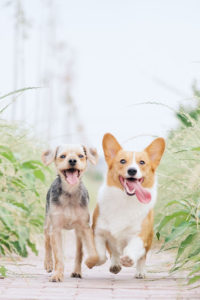Have you ever seen pictures or videos of pets that are chubbier than usual? While a few people might think that fat pets are cuter or fluffier than their lean counterparts, obesity might actually cause unprecedented risks for a lot of pets, regardless of their breed. Unfortunately, the problem of pet obesity has been on the rise — with veterinarians noting a 108% increase in the occurrence of obesity in pets during this pandemic. This means that more pets now have a higher risk of developing osteoarthritis, diabetes, high blood pressure, and a plethora of other health problems associated with pet obesity.
Maybe you’re a pet parent or you’ve been scouting out for breeders puppies – whichever you are, knowing how to take care of pets is absolutely crucial in owning a dog. And an important part of pet care is knowing how to help your pets lose weight or at least keep their weight at a healthy level. In this article, we’ll discuss how you can keep your pets active and how you can help them lose excess fat with a healthy approach. Here are a few tips and recommendations:
- Skip the self-feeder.
One of the possible culprits of obesity in pets is their ability to eat whenever they want with self-feeders. These typically work as a dog food buffet for some pets, allowing them to eat meals at random times of the day, whether they’re hungry, bored, or just snacky. The same goes for automatic feeders, with most machines overfeeding pets, effectively causing more weight gain.
If you think that your self-feeder is playing a large role in causing your pet’s obesity, switch to a more manual way of feeding pets. Measure their rations by hand and serve them their meals at certain time intervals. If you’re not at home the whole day, try hiring a trustworthy pet sitter who can take care of your dog and give them their meals throughout the day.
- Consider additional exercise routines.
While you might be regularly walking your dog for a few minutes each day, this may not be enough, especially if you keep large dogs in small living areas. Different dog breeds have varying exercise requirements, making it absolutely crucial for you to know their needs. For larger dogs, you may need to incorporate more physical activities into their daily routine. Supporting their mobility is also crucial to ensure that their joints and bones are strong and can easily support their weight. Try using toys to stimulate play, such as frisbees and balls, and give them supplements to maintain their health with the additional physical activities.
Just make sure that you ease your pets into additional play or exercise activities to lower their risk of injuries. If your pet is obese, try adding about 10% to 20% to the time that they spend on walks. Ensure that they’re also properly hydrated by bringing water with you to avoid overheating while you’re out and about.
 https://unsplash.com/photos/1VgfQdCuX-4
https://unsplash.com/photos/1VgfQdCuX-4
- Hold off on the treats.
Is your dog treat-driven during training? While treats are great motivators for puppies and full-grown dogs, they are also rich in calories, which may exacerbate your pet’s obesity. Remember that treats should only take up at most 10% of your pet’s diet. Giving them more than than may just make it harder to keep them at a healthy weight. Try shifting to other motivators, such as praise or positive reinforcement.
There’s also the option of using low-calorie treats or more natural treat options, such as carrot sticks, deseeded apple slices, and bananas. Your pets may even benefit from the nutrients that these healthy treats offer!
- Have your pet checked to rule out health conditions.
In some cases, pet parents may overlook certain health conditions that may be causing their pet’s obesity, including hypothyroidism and insulinoma. If you think that your pet is obese, raise the issue at your next vet visit. You can also request a full workup to test for possible conditions that your pet may be suffering from. Aside from checking the possible cause of your pet’s obesity, regular check-ups will also ensure that your pet is healthy.
- Switch to a high-protein, low-carb dog food.
Lastly, your pet’s weight is highly influenced by their food quality. If you’re feeding your pets a purely dry food diet, these foods may actually be the culprit of your pet’s obesity. While kibble is one of the easiest dog foods you can feed your pets since it’s shelf-stable and it requires little to no preparation, it contains high levels of carbohydrates. With dogs having a relatively carnivorous/omnivorous diet, giving them carbohydrate-loaded food will fuel obesity and cause fast weight gain.
Try switching to low-carbohydrate options, such as fresh food or canned wet food, for a nutrient-balanced diet. If you’re unsure how to tweak your pet’s meals, try consulting your vet or a pet nutritionist so that they can help you find better food options for your pets.








